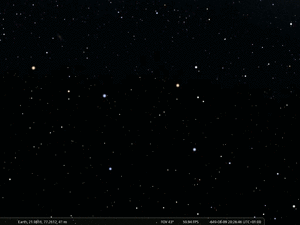Uttara Bhadrapada: Difference between revisions
No edit summary |
No edit summary |
||
| Line 19: | Line 19: | ||
===Transfer and Transformation of the Constellation=== |
===Transfer and Transformation of the Constellation=== |
||
<gallery> |
|||
File:Tibet nakshatra 25.png|Uttara Bhadra, Tibetean |
|||
File:壁宿(仏像図彙).png|Uttara Bhadra, Chinese |
|||
File:26 UttaraBhadrapada draw.png|reconstructed by Jones (1720) |
|||
</gallery> |
|||
==Mythology== |
==Mythology== |
||
Revision as of 09:04, 31 October 2025
Uttara Bhādrapada (उत्तर भाद्रपदा), The Second Blessed Foot, is an Indian name, used by the Indian Vedic tradition. Most of these names are roughly 3000 years old. They pre-date Hinduism but were taken over by it. Identified with γ Pegasi and α Andromedae.
Etymology and History
Name Variants
- Uttara Bhādrapada
- Uttara Bhadrapada
- Ahirbudhnya,
- Dvitiyabhādra,
- Upāntya
Origin of Constellation
Uttara Bhadrapada literally means "the second of the blessed feet". Together with Purva Bhadrapada, the first of the blessed feet, it forms a super-constellation. Yet, in temples the two asterisms with similar names are depicted in totally different ways. This one is drawn as a anthropomorphic figure with two faces who holds the two stars in their hands. The two stars are likely to be identified with γ Pegasi and α Andromedae.
The two Bhadrapada asterisms equal the Chinese Eastern Wall (壁宿) and Encampment (Ying Shi, Mansion) who also form lunar mansions.
Transfer and Transformation of the Constellation
Mythology
mnemonic tales and cultural significance
Weblinks
References
- References (general)









